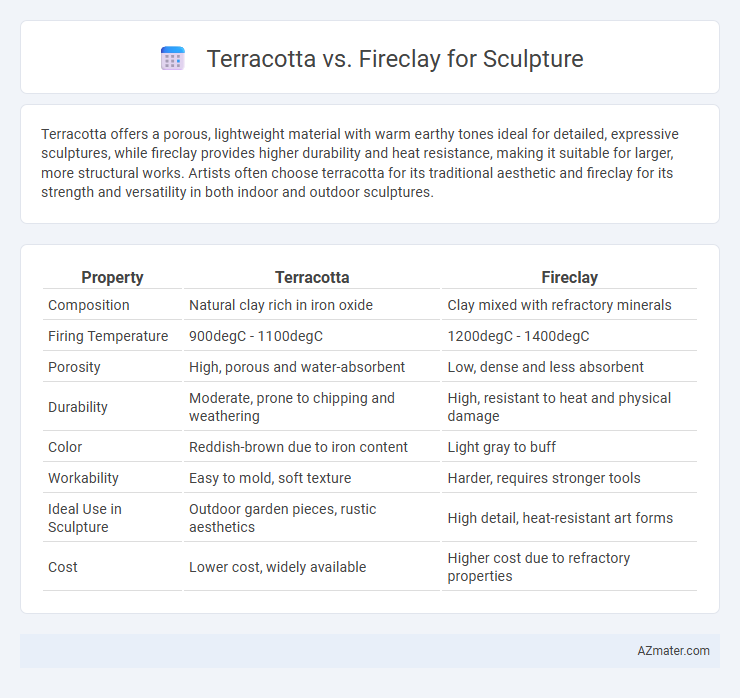Terracotta offers a porous, lightweight material with warm earthy tones ideal for detailed, expressive sculptures, while fireclay provides higher durability and heat resistance, making it suitable for larger, more structural works. Artists often choose terracotta for its traditional aesthetic and fireclay for its strength and versatility in both indoor and outdoor sculptures.
Table of Comparison
| Property | Terracotta | Fireclay |
|---|---|---|
| Composition | Natural clay rich in iron oxide | Clay mixed with refractory minerals |
| Firing Temperature | 900degC - 1100degC | 1200degC - 1400degC |
| Porosity | High, porous and water-absorbent | Low, dense and less absorbent |
| Durability | Moderate, prone to chipping and weathering | High, resistant to heat and physical damage |
| Color | Reddish-brown due to iron content | Light gray to buff |
| Workability | Easy to mold, soft texture | Harder, requires stronger tools |
| Ideal Use in Sculpture | Outdoor garden pieces, rustic aesthetics | High detail, heat-resistant art forms |
| Cost | Lower cost, widely available | Higher cost due to refractory properties |
Introduction to Terracotta and Fireclay
Terracotta, a porous, reddish-brown clay fired at lower temperatures, offers a warm, earthy texture ideal for traditional sculpture with moderate durability. Fireclay, known for its high alumina content and ability to withstand temperatures above 1300degC, provides superior strength and heat resistance, making it suitable for detailed, enduring sculptural works. Both materials allow for versatile artistic expression, but fireclay's enhanced durability makes it preferred for outdoor and functional sculptures.
Composition and Material Differences
Terracotta is primarily composed of porous red clay fired at lower temperatures, resulting in a softer, more porous texture suitable for detailed but less durable sculptures. Fireclay contains a higher concentration of alumina and silica, allowing it to be fired at much higher temperatures, which produces a denser, stronger, and more heat-resistant material ideal for more durable, fine art sculptures. The compositional differences influence sculpting techniques and longevity, with terracotta offering ease of shaping and fireclay providing structural resilience.
Workability and Sculpting Techniques
Terracotta offers excellent workability due to its softer, more malleable clay composition, allowing artists to easily shape and refine intricate details with hand tools or carving instruments. Fireclay, known for its higher refractory properties and denser texture, demands more effort when sculpting but provides superior durability and resistance to cracking during firing. Sculptors often prefer terracotta for fine, delicate modeling, while fireclay suits robust, structural pieces that require strength through repeated firings.
Firing Temperatures and Processes
Terracotta typically fires at lower temperatures between 1,000degC and 1,150degC, resulting in a porous and slightly soft texture ideal for detailed sculptural work. Fireclay requires higher firing temperatures ranging from 1,200degC to 1,300degC, producing a denser, more durable finish suitable for outdoor sculptures and heavy-duty applications. The different firing processes influence color, strength, and porosity, with terracotta offering warm earthy tones and fireclay delivering a more vitrified, stone-like appearance.
Color and Surface Texture Comparison
Terracotta offers a warm, reddish-brown hue with a porous, matte surface that enhances rustic and earthy sculptures, while fireclay presents a smoother, more refined texture with colors ranging from light gray to off-white, ideal for detailed and polished finishes. The natural iron content in terracotta contributes to its rich, oxidized coloration, whereas fireclay's refined composition allows for a consistent, less absorbent surface. Sculptors often choose terracotta for its organic aesthetic, whereas fireclay is preferred for works requiring high detail and durability in glazing.
Durability and Longevity
Terracotta offers moderate durability with a porous structure that can be prone to chipping and weathering over time, making it more suitable for indoor sculptures. Fireclay, composed of highly refractory materials, provides superior durability and resistance to high temperatures, cracking, and erosion, enhancing the longevity of outdoor and high-stress art pieces. Sculptors seeking long-lasting sculptures often prefer fireclay for its robustness and ability to maintain structural integrity under varied environmental conditions.
Suitability for Indoor and Outdoor Sculptures
Terracotta offers excellent suitability for indoor sculptures due to its porous nature, which requires sealing to prevent moisture damage, making it less ideal for prolonged outdoor exposure. Fireclay, known for its higher durability and low porosity, is better suited for outdoor sculptures as it withstands weathering, freezing temperatures, and moisture without significant degradation. Both materials require different finishing techniques, with fireclay often preferred for garden or public art installations due to its resistance to environmental elements.
Cost and Availability
Terracotta offers an affordable and widely available option for sculptors, with clay sourced easily from many regions, making it ideal for budget-conscious projects. Fireclay, while more expensive due to its heat-resistant properties and refined composition, is less readily accessible and often sourced from specialized suppliers. The cost difference between terracotta and fireclay significantly influences material choice, especially for large-scale or commercial sculptures.
Environmental Impact and Sustainability
Terracotta sculptures, made from natural clay fired at lower temperatures, have a smaller carbon footprint compared to fireclay, which requires higher firing temperatures and more energy consumption. Terracotta's biodegradability and use of abundant raw materials enhance its sustainability, whereas fireclay's densified structure offers durability but may involve more intensive mining practices. Selecting terracotta supports eco-friendly art practices by minimizing energy use and promoting natural material cycles.
Choosing the Best Material for Your Sculpture
Choosing the best material for your sculpture depends on durability and finish preferences; terracotta offers a warm, porous texture ideal for detailed, smaller works, while fireclay provides higher strength and heat resistance suited for larger, outdoor pieces. Fireclay's dense composition makes it less prone to cracking and suitable for intricate, durable sculptures exposed to weather elements. Terracotta remains a popular choice for traditional, raw aesthetics, but fireclay's resilience gives it an edge in longevity and structural integrity in sculptural applications.

Infographic: Terracotta vs Fireclay for Sculpture
 azmater.com
azmater.com